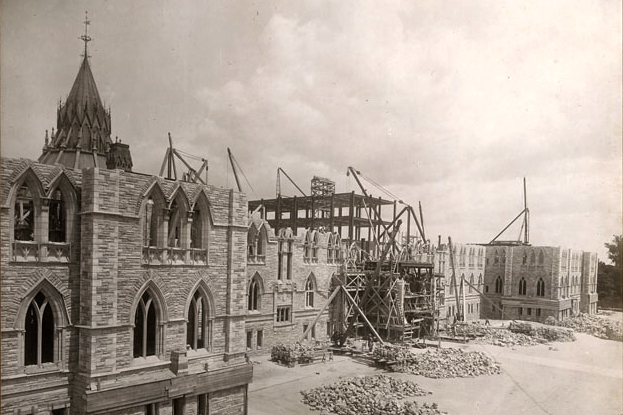Commemorating the anniversary of Centre Block’s reconstruction


A little more than 100 years ago, Parliament Hill was a confusion of mud, scaffolding and construction cranes. Then, one day in early July 1917, the machinery went silent and a ceremony was held in the middle of the construction site to inaugurate Canada’s newest Parliament Building.
Just 17 months after the infamous February 1916 fire destroyed the original Centre Block, reconstruction of its replacement reached the third-storey level. It was clear the new Centre Block would be larger and more spectacular than its predecessor.
The ceremony was modest but poignant. From a makeshift dais, then-prime minister Sir Robert Borden paid tribute to the Fathers of Confederation who created the country 50 years earlier, as well as to Canadians serving in the First World War.
“It is the spirit of those who founded this Confederation that inspires the men who hold the lines in France and in Flanders,” he proclaimed.
Dignitaries, including the governor general and opposition leader Sir Wilfrid Laurier, addressed the crowd. Seven military units presented arms along with 250 veterans. As a choir concluded the singing of “O Canada,” the governor general released a Union Jack to unveil an inscription on the central pillar of Confederation Hall:
On the fiftieth anniversary of the Confederation of British colonies in North America as the Dominion of Canada the Parliament and people dedicate this building in process of reconstruction after damage by fire as a memorial of the deeds of their forefathers and of the valour of those Canadians who in the Great War fought for the liberties of Canada, of the Empire and of humanity.
In 2017 — on the 100th anniversary of the ceremony — nearly 100 parliamentarians, including senators Diane Bellemare, Joseph A. Day, Elaine McCoy, Larry W. Smith, René Cormier and Terry M. Mercer, gathered in Confederation Hall to mark the original event.
Senate Speaker George J. Furey had addressed the group to celebrate the architectural legacy of that 1917 event.
He recalled the words of Sir Robert Borden, who had said the new structure would symbolize “the splendid achievement of the past and the still more glorious hope of the future.”
Those words still resonate, Speaker Furey said at the time.
“Let us not only reflect on the last century, but also look ahead, on the eve of Canada’s 150th birthday, as we approach the restoration of this magnificent building for future generations.”
Although Centre Block was shuttered in February 2019 for rehabilitation work — a project that is expected to last at least 10 years — Canadians can still experience its art and architecture through the Senate’s immersive virtual tour.
An earlier version of this article was published on June 30, 2017.
Related articles
Tags
Committee news
Commemorating the anniversary of Centre Block’s reconstruction


A little more than 100 years ago, Parliament Hill was a confusion of mud, scaffolding and construction cranes. Then, one day in early July 1917, the machinery went silent and a ceremony was held in the middle of the construction site to inaugurate Canada’s newest Parliament Building.
Just 17 months after the infamous February 1916 fire destroyed the original Centre Block, reconstruction of its replacement reached the third-storey level. It was clear the new Centre Block would be larger and more spectacular than its predecessor.
The ceremony was modest but poignant. From a makeshift dais, then-prime minister Sir Robert Borden paid tribute to the Fathers of Confederation who created the country 50 years earlier, as well as to Canadians serving in the First World War.
“It is the spirit of those who founded this Confederation that inspires the men who hold the lines in France and in Flanders,” he proclaimed.
Dignitaries, including the governor general and opposition leader Sir Wilfrid Laurier, addressed the crowd. Seven military units presented arms along with 250 veterans. As a choir concluded the singing of “O Canada,” the governor general released a Union Jack to unveil an inscription on the central pillar of Confederation Hall:
On the fiftieth anniversary of the Confederation of British colonies in North America as the Dominion of Canada the Parliament and people dedicate this building in process of reconstruction after damage by fire as a memorial of the deeds of their forefathers and of the valour of those Canadians who in the Great War fought for the liberties of Canada, of the Empire and of humanity.
In 2017 — on the 100th anniversary of the ceremony — nearly 100 parliamentarians, including senators Diane Bellemare, Joseph A. Day, Elaine McCoy, Larry W. Smith, René Cormier and Terry M. Mercer, gathered in Confederation Hall to mark the original event.
Senate Speaker George J. Furey had addressed the group to celebrate the architectural legacy of that 1917 event.
He recalled the words of Sir Robert Borden, who had said the new structure would symbolize “the splendid achievement of the past and the still more glorious hope of the future.”
Those words still resonate, Speaker Furey said at the time.
“Let us not only reflect on the last century, but also look ahead, on the eve of Canada’s 150th birthday, as we approach the restoration of this magnificent building for future generations.”
Although Centre Block was shuttered in February 2019 for rehabilitation work — a project that is expected to last at least 10 years — Canadians can still experience its art and architecture through the Senate’s immersive virtual tour.
An earlier version of this article was published on June 30, 2017.


